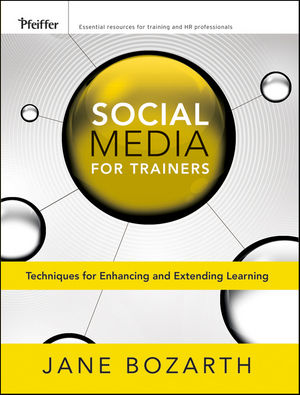Social Media for Trainers: Techniques for Enhancing and Extending LearningISBN: 978-0-470-63106-5
Paperback
192 pages
September 2010, Pfeiffer
 |
||||||
List of Tables and Figures ix
Acknowledgments xiii
Introduction: Getting the Most from This Resource 1
CHAPTER 1 The Basics 11
What Is Social Media? 11
Why Social Media in Training? 13
Which One? 15
Choosing What to Use When 16
Getting Started 18
Summary 22
CHAPTER 2 Twitter 23
In a Nutshell 23
In a Larger Container 23
How to View Twitter 23
Advantages/Disadvantages of Twitter in Training 23
Why Twitter Instead of Something Else? 25
Why Twitter in Addition to Something Else? 25
Getting Started 26
Before the Training Event 33
Pre-Work 35
In Class 36
Intersession Work 37
Formative Evaluation 44
Summative Evaluation 44
Post-Class: Extending the Life of the Training 45
Twitter Tools 47
Inside the Enterprise 50
Case: Microblogging at Qualcomm 50
Summary 52
CHAPTER 3 Facebook and Other Communities 53
In a Nutshell 53
In a Larger Container 53
How to View Facebook 54
Advantages/Disadvantages of Facebook in Training 55
Why Facebook Instead of Something Else? 56
Why Facebook in Addition to Something Else? 56
Getting Started 57
Once Your Personal Page, Group, or Fan Page
Is Set Up 63
Prior to Course Start 69
Intersession Work 71
Building a Learning Community with Facebook 74
Case: Facebook as a Community for InSync
Training, LLC, Course Graduates 75
And Now, a Few Words about LinkedIn 77
Summary 82
CHAPTER 4 Blogs 83
In a Nutshell 83
In a Larger Container 83
How to View Blogs 83
Advantages/Disadvantages of Blogs in Training 84
Why Blogs Instead of Something Else? 87
Why Blogs in Addition to Something Else? 87
Getting Started 88
To Provide a Course Site or Host an Online Course 90
Case: Public Library Uses a Blog to Host a Course 91
To Support a Traditional Course 91
Pre-Work 92
Intersession Work 94
Formative and Summative Evaluation 103
Final Projects 105
Post-Course 105
Building a Learning Community 105
Summary 108
CHAPTER 5 Wikis 109
In a Nutshell 109
In a Larger Container 109
How to View Wikis 109
Advantages/Disadvantages of Wikis in Training 109
Why Wikis Instead of Something Else? 110
Why Wikis in Addition to Something Else? 110
Getting Started 111
Hosting an Online Course 111
Case: Jive Software Uses Wiki to Host a Course 112
In Addition to an Online Course 116
To Support a Traditional Course 117
Pre-Work 118
Intersession Work 118
Post-Course 124
Formative and Summative Evaluation 125
Building a Learning Community 125
Summary 126
CHAPTER 6 Other Tools 127
Google Wave 127
Google Docs 128
YouTube 130
Case: Interactivity via YouTube 131
TeacherTube 135
Social Bookmarking 137
SlideShare 138
Free Virtual Classroom Tools 139
Skype 139
VoiceThread 140
Mashups: Game Changers 140
UStream 141
Summary 141
CHAPTER 7 The Bigger Picture 143
Well First, What Is “Learning”? 144
What Is Social Learning? 145
What Does Social Learning Look Like? 146
Case: Online Community Managed by Employees
of Government Agency 154
And Now, 268 Words About Knowledge Management 155
Social Learning: How to Do Things Versus How to
Get Things Done 156
What’s the Future? 158
Getting Started with Social Learning 160
Summary 162
Afterword: Be the Change 163
Selling the Change 163
Being the Change 165
Appendix 167
References and Suggested Reading 171
About the Author 175



